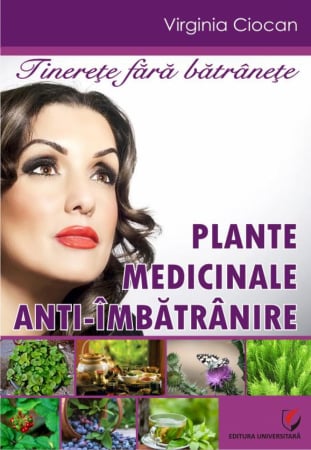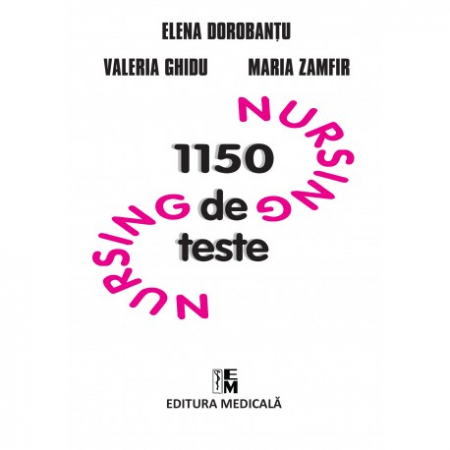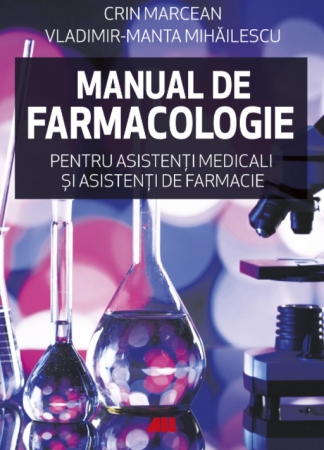ISBN: 978-606-28-1060-3
DOI: https://doi.org/10.5682/9786062810603
Publisher year: 2020
Edition: II
Pages: 236
Publisher: Editura Universitară
Author: Virginia Ciocan
- Description
- Authors
- Content
- More details
- Reviews (0)
Nowadays, it is much more important to feel good when you wake up in the morning, without resorting to medication, to be dynamic and energetic, with a zest for life, even if a hard day awaits you, with many problems to solve in the family or at work. This well-being is even preferable to the absence of diseases or physical defects, which may be present in our lives.
Health and strength of work, energy and optimistic attitude towards life, the joy of living and slowing down aging, maximum physical and intellectual efficiency and, why not, the desire to stay young and active until old age, can be achieved very easily using the immense green pharmacy of nature, which God, in his great generosity and love, gave to men.
Green medicines, as they are metaphorically called medicinal plants, are those with which the ancestral desires of man of all times can be realized, nature being the most sophisticated and well endowed among the laboratories of the world, with results that can no longer be disputed by anyone. even by the most skeptical specialists in the field of classical medicine.
After, for millennia, phytotherapy has provided drugs for all ailments, the modern and explosive development of allopathic medicine of the last century, based on synthetic chemical drugs, has made herbal medicine a Cinderella of medicine, throwing it into a cone. of the shadow that, even today, is still felt.
The undeniable successes of modern pharmaceuticals have been sprinkled with many failures, but also with unfulfilled promises, such as the eradication of serious diseases, such as cancer. Officially, World Health Organization statistics show that the fourth leading cause of death in the world is the abuse of synthetic drugs. Clinical chemistry has exceeded, in the opinion of many specialists, the measure and has gone from use to abuse, and this fact cannot be ignored, due to the effects, often generating death.
Phytotherapy, however, has evolved and passed from the empirical, traditional phase, to a higher stage, scientific and modern, now recognized by more and more specialists. The relaunch of phytotherapy was done in parallel with the fight against amateurism, conservatism and even scientific fanaticism, and now continues to gain ground. In the not too distant future, phytotherapy will develop so harmoniously that it will be able to prove that each person can become his own doctor, through a totally changed paradigm approach, in harmony with nature and with the Christian-Orthodox religion.
Phytotherapy uses plants in their total form, unlike allopathic medicine which recommends only plant extracts. Phytotherapy approaches the human being holistically, as a whole and goes directly to the cause that generated the disease.
Unlike synthetic medicines, green medicines are more accessible, being easy to buy, from your own garden, from forests, pastures or unpolluted orchards, during nature trips and they are incomparably cheaper.
Medicinal plants have, with few exceptions, a milder action and are almost completely free of side effects when the dose is observed. Patients treated with phytotherapy are taken as a whole, the physical and psycho-emotional effects balancing the whole body. In addition, they can be used in parallel with synthetic drugs, when the effect is synergistic.
Green medicines give good results in the early stages of all diseases and have very good results in their prophylaxis. In serious or chronic diseases, green medicine has a valuable adjuvant role. But in natural medical practice, the patient matters more and then the disease and, very often, the patient's desire to heal works true miracles, which contradicts medical science and defeats the disease, even in serious conditions such as cancer.
There are many world-renowned practitioners in natural medicine, such as Dr. Jean Valnet in aromatherapy, Dr. Dean Ornich in heart disease, Dr. Max Gerson and Dr. Rudolf Breuss in cancer therapy, who have demonstrated, through practical results, that these serious diseases can be cured with natural therapies.
They respond very well to green medicines such as: allergies, asthma, some forms of rheumatism, skin diseases, psychosomatic diseases, neuroses, insomnia, memory disorders in the elderly, chronic microbial infections, parasitosis, some viral infections, stress and exhaustion, deficiencies in certain vitamins and minerals, chronic intoxication, hypercholesterolemia, gastric ulcer, biliary dyskinesia, enterocolitis, irritable bowel syndrome
In most cases, the effects of green medicines are felt over time and prolonged administration is required, from a few weeks to no less than three to six months, depending on the age and severity of the disease, but also the response of the body and of the patient's perseverance. In serious chronic conditions such as cardiovascular disease, hepatitis, diabetes or cancer, treatment can take several years.
Phytotherapy does not replace or underestimate the classic medical act, but completes it, having the unanimous merit recognized that it strengthens it, and in some cases prepares the body for a long-lasting allopathic treatment.
It is no secret that in the general opinion of the people there has been a turning point in the aggressiveness of synthetic drugs, a position currently adopted by many doctors who no longer prescribe antibiotics or other chemical drugs, except in strictly necessary cases.
Unfortunately, people have moved further and further away from simple life in accordance with nature, they have adopted unhealthy habits, such as excessive consumption of tobacco, coffee, alcohol, drugs and ethnobotanicals. They are disordered at work, but also at rest, they live in stress and polluted environment, they have an unhealthy diet and then the body struggles to annihilate these recklessnesses, and medicinal plants are what really help people to overcome periods of crisis.
The mentality that we can resort to phytotherapy only when we have exhausted the methods of classical medicine and we are declared incurable is totally wrong. That is why it is necessary to fight with the causes of the disease, not with its effects. The methods are at hand using medicinal plants in the form of infusions, decoctions, tinctures, syrups, extracts in water, vinegar or oil, compresses or poultices.
Personally, I believe that it is not too late to relearn the laws of nature and the principles of traditional Romanian medicine that help us get rid of the so-called diseases of civilization, blood pressure, atherosclerosis, heart disease, high cholesterol, stress. In the case of serious diseases, such as cancer or diabetes, it is normal to block their evolution by the methods of classical medicine, and then to maintain the balance between the body and the disease with the help of medicinal plants. Take the example of our cat or dog that eats grass when they have health problems, or of small mammals in the forest, which when injured, look for patches of plantain on which they roll to heal.
Personally, I have been concerned with medicinal plants and phytotherapy since the Faculty of Biology-Bucharest and doctoral training in general ecology and, although I worked in microbiology applied in biotechnology in chemical and animal husbandry, green drugs were a permanent hobby. , practiced by me even after retirement.
The notes and results of my own research would probably have remained a scientific literature in the drawer, if I did not myself suffer from atherosclerosis, ischemic heart disease and cholesterolemia, diseases that caused over time the stenosis of the subclavian artery, operated by cardio-axillary bypass. After the operation, during convalescence and after that, I experienced everything I knew about the phytotherapy of cardiovascular diseases and, practically, I changed my lifestyle.
From my position as a specialist in biology and biochemistry, a good connoisseur of medicinal plants and a practitioner of aromatherapy by massage with aromatic oils prepared personally, I join my writing with eminent Romanian phytotherapists, recognized worldwide, such as Pavel Chirila, Virginia Faur, Stefan Manea, Valeriu Popa, Doru Laza, with a strong desire to share with Romanian readers about the medicinal power of medicinal plants, an inexhaustible source of health, peace and beauty of body and soul.
I suggest to those who will lean on this book to obtain their own medicinal plants directly from nature, from unpolluted places, from spontaneous or cultivated flora in Romania. Purchasing green medicines from spontaneous vegetation or from your own garden or from relatives in the country, offers in addition to the advantage of a very low cost and the opportunity to exercise.
With love for every plant, even weed, left by God in our country, I consider the whole of Romania a huge green pharmacy where we can buy precious green medicines to alleviate physical and emotional suffering. I hope that my writing will help readers to love and respect medicinal plants, but also to organize in their own household a small green pharmacy, where there is no shortage of teas, tinctures, syrups and other green medicines.
Graduate of the Faculty of Biology - University of Bucharest, Plant Protection Department.
Doctor in Biological Sciences, specialty General Ecology.
Scientific researcher at: Danube Delta Power Plant Tulcea, Maliuc, Sulina; Research and Engineering Center Technology (CCIT) - Fagaras; Institute of Animal Biology and Nutrition (IBNA) - Balotesti - Ilfov.
Scientific activity: over 500 articles in Romanian, English and French in specialized magazines, 4 OSIM Bucharest patents.
After retirement, he turned the hobby (study of medicinal plants) into a profession, specialized in therapeutic massage and developed his own technique of massage with herbs, which he has been practicing since 2008, called aromatherapy massage, with oils that prepare from aromatic plants such as: basil, sage, lavender, bay leaf.
She has written and published since 2007, 9 books on health through alternative therapies, popularizing phytotherapy, as a safe method of preventing and treating diseases, namely:
Blood group (O-I, A-II, B-III, AB-IV) and individual life (Grupa de sange ( O-I, A-II, B-III, AB-IV) si viata individuala)
Health and beauty through aromatherapy and massage (Sanatate si frumusete prin aromaterapie si masaj)
Ethnobotanical plants - between truth and danger (Plante etnobotanice - intre adevar si pericol)
Green medicines from nature pharmacy (Medicamente verzi din farmacia naturii)
Prevents and defeats the disease with immune and adaptogens plants (Previne si invinge boala cu plante medicinale imunitare si adaptogene)
Cherish your heart - cardiovascular herbs (Pretuieste-ti inima - plante medicinale cardiovasculare)
Aromatherapy by massage (Aromaterapie prin masaj)
Youth without old age - anti-aging herbs (Tinerete fara batranete - plante medicinale anti-imbatranire)
Water - natural medicine (Apa - medicament natural)
In the footsteps of Cleopatra - Journey to Egypt (Pe urmele Cleopatrei - Calatorie in Egipt)
50 minutes in a balloon - Travel to Cappadocia - Antalya (50 de minute in balon - Calatorie in Cappadocia – Antalya)
FOREWORD / 9
INTRODUCTION / 12
CHAPTER 1
PHYTOTHERAPY IN THE WORLD AND IN ROMANIA / 18
1.1. General considerations / 18
1.2. Green medicines versus synthetic medicines / 25
CHAPTER 2
ANTI-ALLERGIC MEDICINAL PLANTS / 29
2.1. General considerations / 29
2.2. Three-potato brothers - Viola tricolor / 32
2.3. Echinacea - Echinacea purpurea / 36
2.4. Mousetail - Achillea milefolium / 39
2.5. Great nettle - Urtica dioica / 43
2.6. Chamomile - Matricaria chamomilla / 47
2.7. Grass - Inula helenium / 51
2.8. Loboda - Atriplex hortensis / 54
2.9. Garden stevia - Rumex patientia / 56
2.10. Radish - Raphanus sativus, R. niger / 59
2.11. Soc-black - Sambucus nigra / 62
2.12. Couch Grass - Agropyron repens / 65
CHAPTER 3
CARDIOVASCULAR MEDICINAL PLANTS / 68
3.1. General considerations / 68
3.2. Hawthorn - Crategus monogyna / 80
3.3. Goosefoot - Leonurus cardiaca / 83
3.4. All-heal - Valeriana officinalis / 86
3.5. Fingers - Digitalis purpurea, D. lanata / 88
3.6. Blackcurrant - Ribes nigrum / 91
3.7. Dandelion - Taraxacum officinale / 94
3.8. Shepherd's purse - Capsella-bursa-pastoris / 97
3.9. Horsetail - Equisetum arvense / 99
3.10. Cinnamon - Cinamomum verum / 102
3.11. Ginkgo biloba - Ginkgo biloba / 105
3.12. Oat - Avena sativa / 107
3.13. Mistletoe - Viscum album / 109
3.14. Lily - Convalaria majalis / 112
CHAPTER 4
AROMATIC MEDICINAL PLANTS / 115
4.1. General considerations / 115
4.2. Basil - Ocimum basilicum / 116
4.3. Calomfir - Chrisantemum balsamita / 119
4.4. Garden thyme - Satureja.hortensis / 122
Thyme of culture - Thymus-vulgaris / 122
4.5. Thyme - Thymus serpillum / 125
4.6. Pinus sylvestris (Abies alba, Picea excelsa) - 129
4.7. Juniper - Juniperus communis / 132
4.8. Tuia - Thuja occidentalis, T. orientalis / 135
4.9. Dafin - Laurus nobilis / 138
4.10. Levantica - Lavandula angustifolia / 141
4.11. Mint-garden - Mentha piperita / 144
4.12. Citrus (Lemon Tree, Orange Tree) - (Citrus limon, Citrus aurantius) / 147
4.13. Garden sage - Salvia Officinalis / 153
CHAPTER 5
IMMUNE AND ADAPTOGENIC MEDICINAL PLANTS / 157
5.1. General considerations / 157
5.2. Sea buckthorn - Hippophae rhamnoides / 159
5.3. Brier - Rosa canina / 164
5.4. Wild garlic - Allium ursinum / 168
5.5. Garlic - Allium sativum / 173
5.6. Marigold - Calendula officinalis / 178
5.7. Melissa - Melissa officinalis / 181
5.8. Homemade aloe - Aloe vulgaris / 186
CHAPTER 6
APHRODISIAN MEDICINAL PLANTS / 192
6.1. General considerations / 192
6.2. Drainers - Dactylorhyza maculate / 194
6.3. Bear's branch - Heracleum sphondyllum / 196
6.4. Dill - Anetum graveolens / 199
6.5. Celery - Petroselinum crispum / 202
6.6. Cloves - Eugenia caryophylata / 209
6.7. Napraznic - Geranium robertianum / 209
EPILOG / 213
ANNEX NO. 1 - The botanical and popular name of the medicinal plants mentioned in the paper / 217
ANNEX NO. 2 - Medical terms used in the paper / 221
SELECTIVE BIBLIOGRAPHY / 232
"Health and work power, energy and optimistic attitude towards life, the joy of living and slowing down aging, maximum physical and intellectual performance and, why not, the desire to stay young and active until old age, can be achieved very easily using the huge green pharmacy of nature, which God, in his great generosity and love, gave to people", this is how the author begins her new volume "Green medicines from nature's pharmacy".
Nothing could be further from the truth! From ancient times, for the maintenance of life, people procured food from the environment, first from fruits and weeds, then in addition to vegetables, from the meat of hunted animals. If they became ill or injured, they retreated to caves or forests and alleviated their suffering with the plants they consumed. Man has passed down, from generation to generation, the role of certain plant species in alleviating and healing some sufferings, thus giving birth to Phytotherapy, the science of healing with the help of plants.
After a short history of this science and the important role that medicinal plants played in curing various diseases in antiquity and the Middle Ages, the author emphasizes the gradual replacement of medicinal plants and their preparations with synthetic products so that today , very few people still trust these "cure weeds" and misuse synthetic drugs, whose side effects have not been long in coming.
One such example of strict topicality is the uncontrolled administration of synthetic antibiotics, which has led to the emergence of species of microorganisms, the so-called super-bacteria (about 28 species) that are resistant to absolutely all antibiotics currently marketed.
There are many plant species in nature that can successfully replace synthetic drugs and that can restore the normal functioning of various devices and systems in the human body.
For these reasons, the author aims to bring to the fore the importance of herbs in the therapy of various body dysfunctions.
Structured in five chapters for medicinal plants, the book groups plant species according to the role they play in ameliorating and curing various diseases of the body. Most of the diseases discussed in this writing are conditions caused primarily by daily stress, which manifests itself with more or less serious disorders, but for which many of us use synthetic drugs. Easier and less toxic to the body would be to use herbs in the form of teas, tinctures, syrups and other medicines.
In each chapter are presented a number of 10-12 species of plants, among the best known, emphasizing the role they have in curing various diseases, as well as how they should be administered to be as effective as possible.
I want to mention that the recipes described for obtaining powders, infusions, decoctions and tinctures are recipes of the author who tested the effectiveness of the preparations obtained and recommended herself. I recommend this book to all those interested in the effectiveness of medicinal products and those they do not trust the efficiency of the "cure weeds", with the conviction that it will change their opinion and they will look at the weeds at the edge of the forest with different eyes.
Dr. biologist Cristina Tabuc
INCDBNA Balotesti

6359.png)
![Green medicines from nature pharmacy [1] Green medicines from nature pharmacy [1]](https://gomagcdn.ro/domains/editurauniversitara.ro/files/product/large/Medicamente_verzi,_ed_a_II-a.jpg-2942-7098.jpg)



















